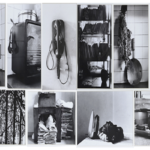Framed
Forever Yours!

Bhupen Khakhar, Pink City,1991
Bhupen Khakhar, Pink City,1991
PRESENTING ART IN THE BEST LIGHT
- Play with the scale of the work, in relation to the room. Display large works on a small wall, leaving not too much room all around. This creates a stunning effect and contrary to our expectations, makes the room seem bigger. Vary proportions of works hung in one room. Some horizontal, one or two strong verticals and perhaps a grouping to enable the eye to move over these changing scales.
- Group black-and-white works on paper, which use difference techniques. For instance, a drawing that uses lines next to another drawing that shows shading and volume; or one with a use of cross hatch or abstraction. Create a grid on the floor to decide spacing and overall look and then measure the space and hang your works.
- Paint the background wall a contrasting colour. The colour chosen should not be taken from the painting but a contrast that heightens the projection of the image.
- The lighting for artwork need not be ‘supermarket’ bright. It should be used to enhance the content of the artwork. Light sculpture from below to add an element of drama.
- Choose areas of a painting or sculpture to pin point with narrow angle beams.
- Relate art to furniture. If there is a side table, place a picture at a height where it can be enjoyed while seated. Enhance the setting by placing a contemporary table lamp next to it to dramatise the effect of light.
PRESERVING ART FROM THE VAGARIES OF TIME
- Clean the surfaces of your canvases with a wide super-soft paintbrush twice a year. Though this seems obvious, keep an eye on your works periodically. Look closely with a torch using a raking (slanting) light to detect fungus, which could be slowly developing. Take down all your art once a year and sun the back for 30 minutes. Dust both the back and front and rehang.
- Store canvases in mulmul sacks (stitched on three sides) to prevent dust accumulation while allowing the canvas to breathe. Lean in a rack so that the back of the work is facing outwards.
- Most damage to art occurs during the handling. When you move a work, first clear an appropriate space where it can rest. Always handle works with gloves. The less hands that directly touch a work, the better.
- When installing a painting, place spacers at the back, on the outer frame, to enable air circulation behind the painting.
- One encounters a large amount of art that is stored digitally today. Digital storage devices (CDs, hard drives and more) should be checked periodically to ensure that there is no corruption or deterioration of data. Always have a back-up of the data.
Related posts from Verve:
Verve Trending
Sorry. No data so far.
Love Our Site?
us on Facebook to stay updated with the latest trends
us on Facebook to stay updated with the latest trends





